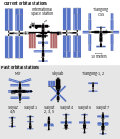Bishop Ring (habitat)
A Bishop Ring[1] is a type of hypothetical rotating space habitat originally proposed in 1997 by of the Institute of Atomic-Scale Engineering.[2] The concept is a smaller scale version of the Banks Orbital, which itself is a smaller version of the Niven ring.[3] Like other space habitat designs, the Bishop Ring would spin to produce artificial gravity by way of centrifugal force. The design differs from the classical designs produced in the 1970s by Gerard K. O'Neill and NASA in that it would use carbon nanotubes instead of steel, allowing the habitat to be built much larger. In the original proposal, the habitat would be approximately 1,000 km (620 mi) in radius and 500 km (310 mi) in width, containing 3 million square kilometers (1.2 million square miles) of living space,[2] comparable to the area of Argentina or India.
Because of its enormous scale, the Bishop Ring would not need to be enclosed like the Stanford torus: it could be built without a "roof",[1] with the atmosphere retained by artificial gravity and atmosphere retention walls some 200 km (120 mi) in height. The habitat would be oriented with its axis of rotation perpendicular to the plane of its orbit, with either an arrangement of mirrors to reflect sunlight onto the inner rim or an artificial light source in the middle, powered by a combination of solar panels on the outer rim and solar power satellites.[2]
Also unlike the 1970s NASA proposals, where habitats would be placed in cislunar space or the Earth-Moon L4/L5 Lagrangian points, Forrest Bishop considered other possible positions, including the much more distant Sun-Earth L4/L5 Lagrangian points, positions closer to the sun, and positions in the asteroid belt or beyond.[2]
Bishop rings in fiction[]
- Bishop Rings are a common type of habitat in the fictional universe of the Orion's Arm worldbuilding project;[4] their radius varies from as little as 100 km to as much as 1000 km (62–620 mi).
- The eponymous ring installations of the Halo video game series are essentially Bishop Rings with slightly divergent proportions. Notably, the Halo rings are located in orbit around gas giants and rocky planets rather than at lagrangian points.
- Orbitals in Ian M. Banks' The Culture novels are a similar concept but much bigger and thus would require much stronger materials.
See also[]
- Halo Array – Fictional ringworlds
- Island Three, another name for O'Neill cylinders
- O'Neill Cylinder
- McKendree cylinder – Hypothetical rotating space habitat
- Orbital (The Culture)
- Ringworld – 1970 science fiction novel by Larry Niven
- Rotating wheel space station
References[]
- ^ a b Rain Noe, "Space Colony Form Factors, Part 3: The Stanford Torus and Beyond", Core77, Aug. 07, 2015. Retrieved 28 May 2018.
- ^ a b c d Forrest Bishop, "Open Air Space Habitats", Institute of Atomic-Scale Engineering, 1997. Retrieved 28 May 2018.
- ^ Adam Hadhazy, "Could We Build a Ringworld?", Popular Mechanics, Sep 4, 2014. Retrieved 28 May 2018.
- ^ M. Alan Kazlev, Todd Drashner and Steve Bowers, "Bishop Ring", Encyclopaedia Galactica website, October 8 2001. Retrieved 28 May 2018.
External links[]
- "Bishop Ring" in the Encyclopedia Galactica at Orion's Arm
- Worldring
- Carbon nanotubes
- Megastructures
- Space habitats
